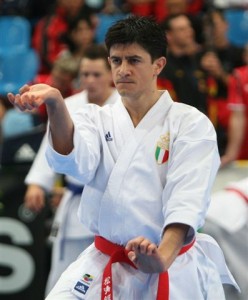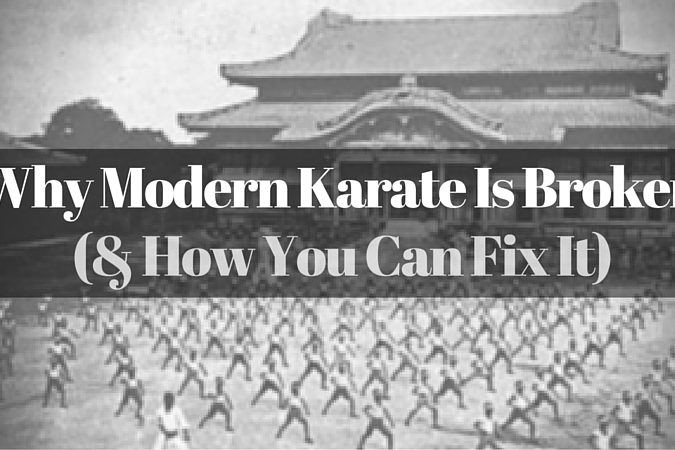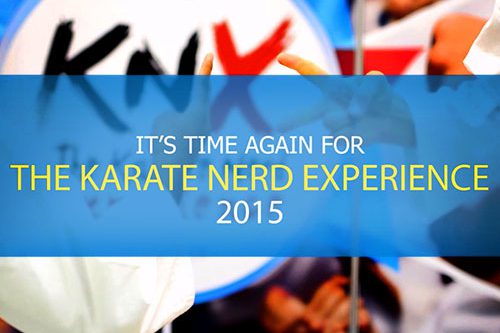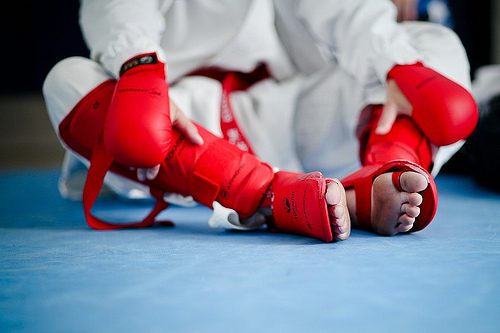This is the second part of my jaw-dropping interview with the brilliant Dr. Lucio Maurino, several times Italian, European and World Champion in Karate (team kata and individual kata speciality), conducted in his beautiful traditional dojo in Italy. If you haven’t read the first part, go here!
Let’s continue…
LM: “As I told you, we have five very important elements that we have to consider in training. Especially in kata. The first one, like we said, is Technique. The second is Power, defined as the product of strength and speed. Many people think power is the same thing as speed, but it’s not like that. The third element, then, to understand is Kime. And for this we must give a rational explanation. Because Kime, in Japanese, can be interpreted to mean a lot of beautiful and interesting things when related to martial arts, budo and Karate [Jesse’s note: read my previous article about the meaning of “kime “here]. But for Sports Science, it’s different, because in sports we have to speak the same language. This is very funny, because every time I give a seminar, I ask: “What is Kime?” and everyone gives me a different answer. Everyone! For example, for you Jesse, what is Kime?”
J: For me? Well, it’s simply… a stop.
LM: “A stop. Yes, but we must go deeper. Biomechanically.”
J: Okay, so it’s a contraction of the muscles, at the end of a technique.
LM: “But we must define exactly what we mean by contraction. There are lots of contractions! So, allow me: Kime is a short isometric neuromuscular contraction. That’s all! Of course, this is from a scientific view. But Kime is just a small isometric contraction, given from an isotonic contraction. First we move, then we stop! [note: to learn more about the basic contractions of a muscle, check out sensei Wikipedia here]”
J: Exactly.
LM: “We stop, we move, and then we stop again. This is the movements of kata. Stop, move, stop, move… and the quicker you move, the better you are. So, it’s very important to understand that acceleration is a focal point of the training. But, think about this: You start from a stop… then you do a movement… then you do another isometric contraction. For every sequence, you have two isometric contractions and only one movement. So the rapport between Kime and acceleration is…”
J: 2:1.
LM: “Two to one. Yes. A little secret…”
J: Very interesting!
LM: “Very interesting, yes! Maybe I have said too much! [laughs hysterically]”
J: I promise to not write this!
LM: “No, no, it’s okay… but let’s continue with the five elements. We already said Technique, Power and Kime, yes? Then, we have Rhythm, which is very important to understand. Although many people cannot define it, in fact, the definition is very simple. Rhythm is the order of things. Everything you see around you has Rhythm. An order we give to things, and their relationship to each other. When we walk up the stairs, we have Rhythm. When we eat, we have Rhythm. When we place items on a desk – papers, pencils, keys – the items have Rhythm. An order. Every time you move, you have Rhythm. Okay? So, this capacity is very important to train. I think a top athlete must have, and must always train, this capacity. The capacity of Rhythm.”
J: So how does one train this capacity? This Rhythm?
LM: “You can improve this capacity in a lot of ways, like training coordination for example, but from my experience also with music. Incredibly, incredibly, I started with this research for my first degree in Sports Science, giving my thesis of increasing coordinative capacity in using Rhythm. This led me to introduce music in Karate. Of course, I was immediately criticized by everybody! People said: “This is unbelievable! You are crazy, you are mad!” But, like we said before, when you are a pioneer you need a lot of time and convincing to get people to accept your ideas.”
J: So how has your “Karate with music”-idea evolved?
LM: Well, today this thing in Italy is very famous. And it’s called Sound Karate. [sensei Maurino is actually the creative director/founder of big projects including SportivArt and Sound Karate, where he mixes music with Karate.]. The interesting thing is, looking back at the ancient Karate practiced in Okinawa, I’ve found that they used to do kata with music too. From sensei Toguchi, in Goju-ryu, I learned that they used to create musical kata with ancient instruments for girls and children [laughs]! Incredible!
J: Interesting observation…
LM: “So, many times what people call “tradition” is more modern than the modern age! The lesson is; when you go deep enough into your research, you will often find what you are looking for. Or, in some cases, what you find just gives more truth to what you already know… your intuitions.”
J: I recognize that feeling very well!
LM: “Going back to the five elements of Karate and kata: Rhythm is a very important thing. The fifth and last thing is Expressiveness: the capacity to communicate – with our body – what we want to communicate. So that your body becomes your pen, and the environment is the paper where you write with your movements. Therefore, Expressiveness is very important.”
J: What about team kata then?
LM: “Yes, this is different. For individual kata, Expressiveness is the fifth and last element, but for team kata it’s not. In team kata, the last element is Synchronization. Synchronization is very important. And you must know that Synchronization has many other important points that we must analyze, but it all starts from the first element, which is…”
J: …Technique.
LM: “Because if we, in the team, have just a little bit different way to move, we will always have great problems with Synchronization. That’s why it always begins with Technique, which is number one. So to sum it up, these five elements are the basic points you must study when you start to train in Karate, especially kata.”
J: I’ve never seen anyone break down Karate like this before! Amazing! So what do you think separates a good Karate-ka from a great Karate-ka?
LM: “I always answer this question in the same way: The difference is in the details.”
J: Go on…
LM: “Details make the difference. In everything.”
J: For example?
LM: “For example… when you change from being a child into a teenager and begin to train more seriously in Karate, you start to think more about how to give the best performance possible, when you are executing the kata. But when you come to the top level in the world, you stop thinking about this and you “become” the kata instead. You start using kata as a way to express yourself.”
J: You actually “use the kata”, instead of being “(ab)used by it”?
LM: “And so you become the kata. That’s a very important difference.”
J: So what part does the psychological element play in the “details”? Since we all basically have two arms, two legs and one head; isn’t the power of the mind one of the most underused resources? How can one harness this power to optimize one’s performance? Do you have any specific techniques for reducing stress and anxiety, or perhaps increasing focus?
LM: “Of course [laughs]! This is NOT a little detail! It’s a great detail! Actually, this is one of the main points I always observe when I am in competition. For example; when you are in the warming up room, you see lots of really good competitors. Maybe you even see them and think: “Wow, that guy can win over me!” …while later, on the tatami, his performance can be very different [bad]! That’s why I told you there is no “best”. Maybe there is the “best” in a specific moment, but not forever! So what I want to say is that the mental approach to a competition is very important.”
J: And what specific advice can you give for the perfect mental approach?
LM: “That if you compete just for your own enjoyment, for your passion… just to communicate or express something… you will definitely achieve a very good way of performance. Unfortunately, many people today compete just to say: “I’m the champion, look at me, I’m very good, I’m nice”. This is not the way.”
J: I agree 110%. I’ve always personally used the “passion approach”. But for those who have a hard time properly expressing themselves – which certainly is no easy task – do you have any fool-proof, practical, techniques for the “regular” people out there?
LM: “Well, as I told you, I had to work a lot on this myself, because from a young age I was always very alone. So I had to work a lot on this skill, because it is a skill. I’ve worked with a lot of psychologists on this. And that’s why, today, I want to share a different Karate with people.”
 J: A different Karate? Explain.
J: A different Karate? Explain.
LM: [continues]”…and when I think about it, maybe that’s the reason I built this traditional dojo, instead of a sport dojo. Why? Because although competitions are good, not many people can take a lot from competition.
Today’s society is very different. I want to say that when I was very young; if I lost a competition it didn’t matter. Today, however, winning is very important for both the competitors and the parents. It’s a big problem! So for this reason I think that if we continue in this way, we cannot evolve. Imagine doing only sport katas, or only the same kata, for 10-15 years just for competition! Without doing anything else – like kumite, bunkai, kihon, self-defense and things like this – I think that we are not promoting the complete, functional and socially effective Karate [what I call being a Karate Nerd™]. So that’s why I want to share today, especially with children, a different Karate.”
J: Which is?
LM: “A Karate for life. Not a Karate for competition. In my last 15 years, when I have taught a lot of Karate to many young competitors, I’ve observed that I have often done an excellent work on the athlete… on the technique, on their training… but not their personality. That’s why, with many of my top athletes, I decided to not train them anymore. Because I think that if you improve your skills, your physical skills, but not your mind and character… you are not practising Karate.”
J: So what are you practising then?
LM: “You are just practising a sport; similar to Karate.”
J: And how do you actually teach this spiritual, mental, character-building element in class?
LM: “For example; a lot of breathing exercises, a lot of meditation, imagery and visualization, lots of things related to the relationship between you and your complementary partner in training, not your “opponent”. Also, accentuate a more global view on Karate. Explain and educate about different styles and ancient values.”
J: Sounds great! What have you results been so far?
LM: “Actually, incredibly, in just a few months I’ve had some great improvements with a few guys I’m training. Not only in their skills, but more specifically in their manners. And for this reason, parents are beginning to tell me: “It’s incredible! Can you come to our home please!?” [laughs]. It’s incredible. And I think this is the way Karate must be approached with persons. It’s very important, this. Only then, after this foundation has been built, maybe you can start to think about some competition.”
J: Word. So why do we even have this problem today, do you think?
LM: “The problem is because the trainers we have today are technicians or coaches. They are not real senseis. Just technicians. They are only thinking: “This kid can be a good competitor for my club!”, so that his club can be famous and he can go and give seminars and get money.”
___________
Stay tuned for part three of the interview – where we finally (!) talk about mental techniques you can use for psyching up/cooling down, optimal peak stress levels, a couple of remarkable anecdotes, top secret training advice, the real power behind breathing and much, much, much more!



14 Comments